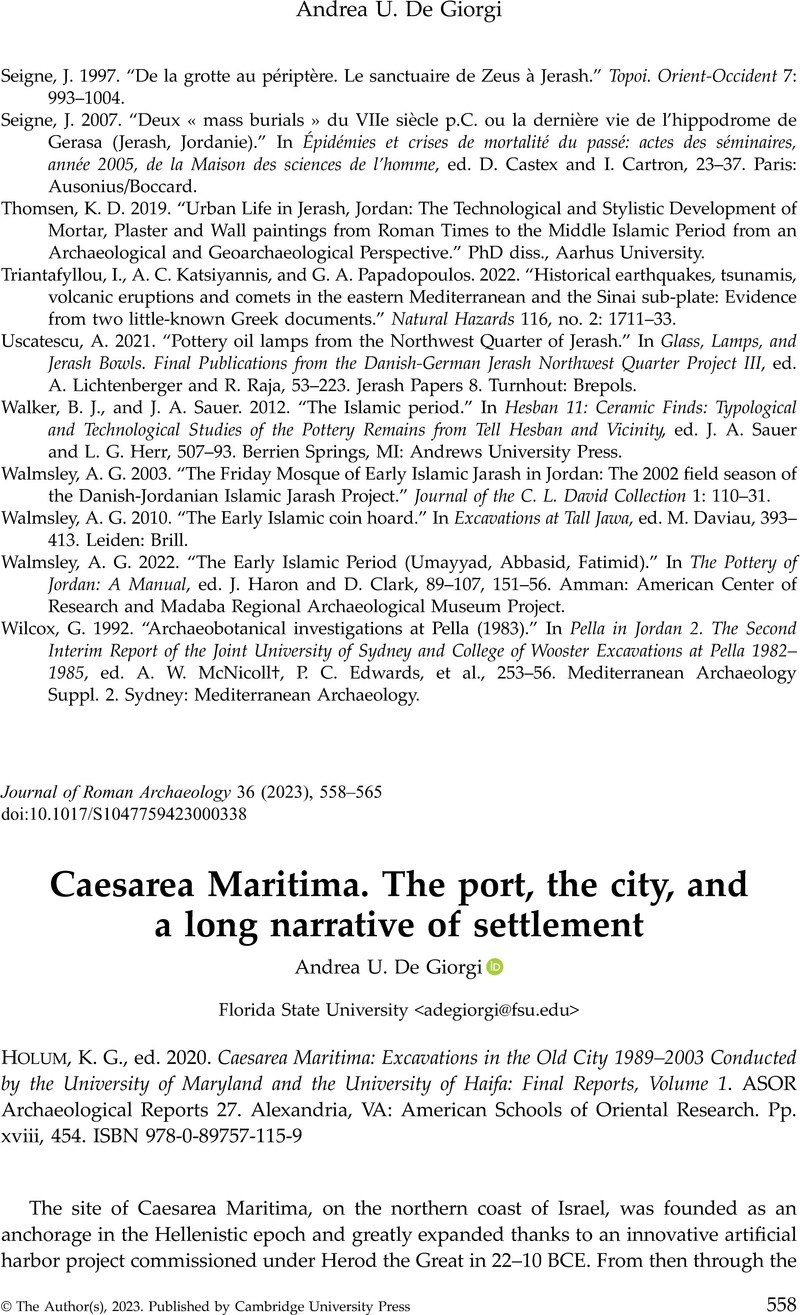No CrossRef data available.
Article contents
Caesarea Maritima. The port, the city, and a long narrative of settlement - K. G. Holum, ed. 2020. Caesarea Maritima: Excavations in the Old City 1989–2003 Conducted by the University of Maryland and the University of Haifa: Final Reports, Volume 1. ASOR Archaeological Reports 27. Alexandria, VA: American Schools of Oriental Research. Pp. xviii, 454. ISBN 978-0-89757-115-9
Review products
K. G. Holum, ed. 2020. Caesarea Maritima: Excavations in the Old City 1989–2003 Conducted by the University of Maryland and the University of Haifa: Final Reports, Volume 1. ASOR Archaeological Reports 27. Alexandria, VA: American Schools of Oriental Research. Pp. xviii, 454. ISBN 978-0-89757-115-9
Published online by Cambridge University Press: 29 September 2023
Abstract
An abstract is not available for this content so a preview has been provided. Please use the Get access link above for information on how to access this content.

- Type
- Book Review
- Information
- Copyright
- Copyright © The Author(s), 2023. Published by Cambridge University Press
References
Arnaud, P., and Keay, S.. 2020. Roman Port Societies: The Evidence of Inscriptions. Cambridge: Cambridge University Press.CrossRefGoogle Scholar
Boas, A. 1992. “Islamic and Crusader pottery (c. 640–1265) from the Crusader city (Area TP/4).” In Caesarea Papers: Straton's Tower, Herod's Harbour, and Roman and Byzantine Caesarea, ed. Vann, R. L., 154–66. JRA Supplement 5. Ann Arbor, MI: Journal of Roman Archaeology.Google Scholar
Borroni, V., Dell'Amore, G., and Frova, A., eds. 1966. Scavi di Caesarea Maritima. Rome: “L'Erma” di Bretschneider.Google Scholar
Goodman-Tchernov, B., Sharvit, J., Artzy, M., and Barkai, O.. 2021. “Caesarea, ancient tsunami research.” Hadashot Arkheologiyot: Excavations and Surveys in Israel 133. (Hebrew)Google Scholar
Holum, K. G. 1992. “Archaeological evidence for the fall of Byzantine Caesarea.” BASOR 286: 73–85.Google Scholar
Porath, Y. 1996. “The evolution of the urban plan of Caesarea's southwest zone: New evidence from the current excavations.” In Caesarea Maritima: A Retrospective after Two Millennia, ed. Raban, A. and Holum, K. G., 105–20. Leiden: Brill.CrossRefGoogle Scholar
Reinhardt, E. G., Goodman, B. N., Boyce, J. I., Lopez, G., van Hengstum, P., Rink, W. J., Mart, Y., and Raban, A.. 2006. “The tsunami of 13 December A.D. 115 and the destruction of Herod the Great's harbor at Caesarea Maritima, Israel.” Geology 34, no. 12: 1061–64.CrossRefGoogle Scholar
Raban, A., and Holum, K. G., eds. 1996. Caesarea Maritima: A Retrospective after Two Millennia. Leiden: Brill.CrossRefGoogle Scholar
Sharon, M. 1996. “Arabic inscriptions from Caesarea Maritima: A publication of the Corpus Inscriptionum Arabicarum Palestinae.” In Caesarea Maritima: A Retrospective after Two Millennia, ed. Raban, A. and Holum, K. G., 401–40. Leiden: Brill.CrossRefGoogle Scholar
Taxel, I., and Roskin, J.. 2022. “Refuse usage and architectural reuse in the field: A view from the Early Islamic Plot-and-Berm agroecosystem to the south of Caesarea/Qaysāriyya (Israel).” Journal of Islamic Archaeology 9, no. 1: 31–58.Google Scholar




